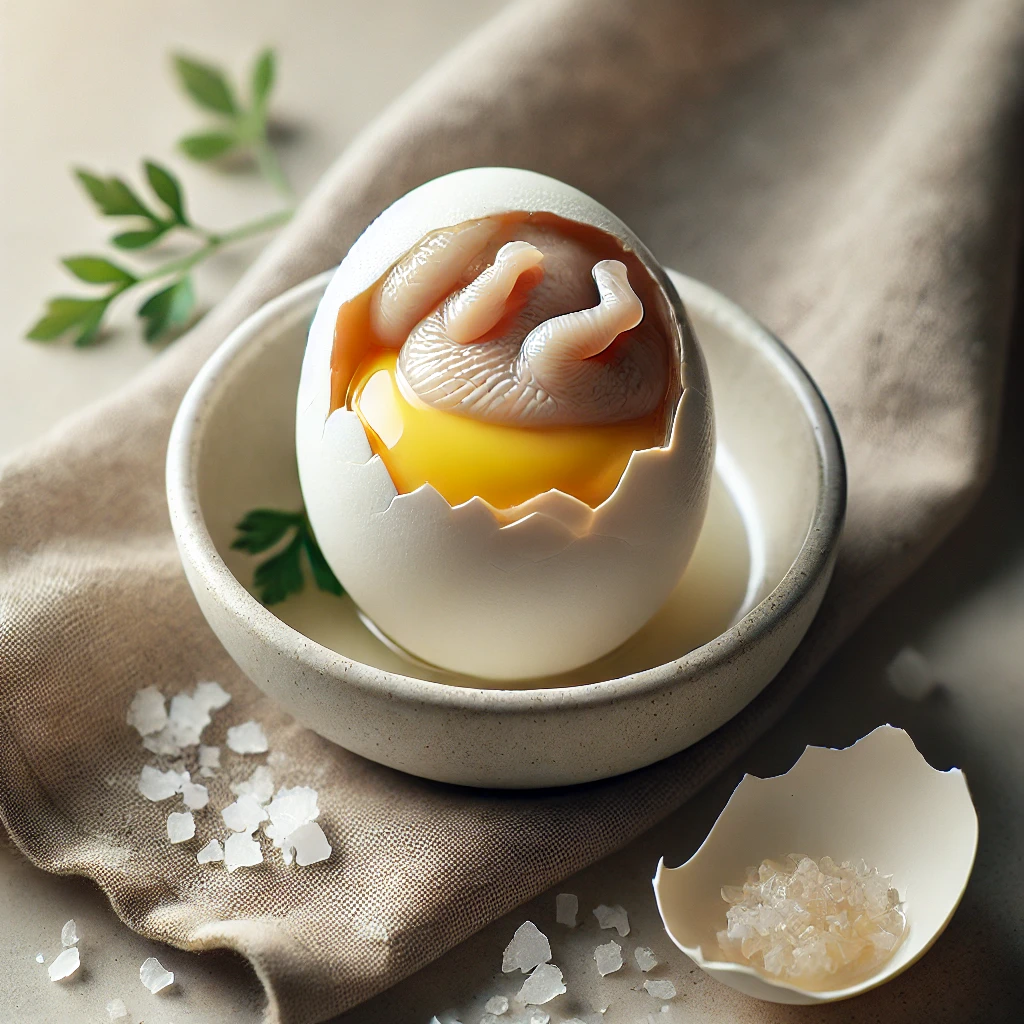Have you ever heard of a dish that’s simultaneously revered as a delicacy and regarded with trepidation by the uninitiated? Enter balut, a unique culinary creation that has been captivating taste buds and raising eyebrows for generations. This fertilized duck egg, typically incubated for 14-21 days, is a staple street food in many Southeast Asian countries, particularly the Philippines. As we embark on this culinary journey, prepare to challenge your preconceptions and explore a dish that’s as rich in flavor as it is in cultural significance.
Balut is not just a food; it’s an experience that engages all your senses. The warm, savory broth that first hits your palate, the tender embryo with its complex textures, and the creamy yolk that melts in your mouth – all these elements come together to create a truly unforgettable gastronomic adventure. While it may not be for the faint of heart, balut has earned its place as a beloved snack and a potent source of nutrition for millions across Southeast Asia.
It’s important to note that this dish is not suitable for vegetarians or vegans. However, for those with an adventurous palate and an open mind, balut offers a unique opportunity to explore a fascinating aspect of Filipino and Southeast Asian cuisine. So, let’s dive into the world of balut and discover why this controversial egg has captured the hearts (and stomachs) of food enthusiasts around the globe.
Recipe Ingredients
Before we delve into the preparation of balut, let’s take a look at what you’ll need. It’s worth noting that balut is typically purchased ready-to-eat, but for those interested in the full process, here’s what you’d need to create balut from scratch:
| Ingredient | Quantity | Notes |
|---|---|---|
| Fresh duck eggs | 12-24 | Fertilized |
| Water | As needed | For incubation |
| Salt | To taste | For serving |
| Black pepper | To taste | For serving |
| Vinegar | Optional | For dipping |
| Chili garlic sauce | Optional | For dipping |
Substitutions:
- While duck eggs are traditional, some regions use chicken or quail eggs for a similar dish.
- If you can’t find fresh fertilized eggs, you may need to source them from a specialized poultry farm or Asian market.
Recipe Instructions
Creating balut from scratch is a lengthy process that requires specific equipment and expertise. However, for the purpose of this blog, we’ll focus on how to properly prepare and eat store-bought balut, which is the more common way to enjoy this delicacy.
Preparing Balut:
- Sourcing: Purchase fresh balut from a reputable Asian market or street vendor. Look for eggs that are about 18 days old for the best balance of flavor and texture.
- Checking Freshness: Gently shake the egg. You should feel some movement inside, indicating that the egg is still fresh.
- Warming: If the balut isn’t already warm, place it in a pot of hot (not boiling) water for about 5 minutes. This will ensure the optimal temperature for consumption.
- Cracking: Gently tap the wider end of the egg on a hard surface to create a small crack.
- Peeling: Carefully peel away a small portion of the shell, creating a hole about the size of a quarter.
Eating Balut:
- Sipping the Broth: Once you’ve created an opening, put your lips to the hole and sip the warm broth. This amniotic fluid is rich in flavor and considered by many to be the best part of the balut experience.
- Seasoning: Sprinkle a pinch of salt into the hole. Some people also like to add a dash of black pepper or chili vinegar for extra flavor.
- Peeling and Eating: Continue to peel the egg, eating the contents with a small spoon or directly from the shell. The white part (albumen) can be quite tough and is often discarded, but the yolk and embryo are the prized portions.
- Savoring: Take your time to appreciate the different textures and flavors. The yolk is creamy and rich, while the embryo has a tender, almost chicken-like consistency.
- Pairing: Balut is often enjoyed with a cold beer or soda, which can help balance the rich flavors of the egg.
Recipe Tips & Variations
Tips for Enjoying Balut:
- Start with a younger balut (around 14-17 days) if you’re new to the dish. These have a less developed embryo and may be easier for beginners to approach.
- Don’t overthink it. Many first-timers find that balut is much more palatable than they expected.
- Try different condiments. While salt is traditional, some enjoy balut with chili garlic sauce, vinegar, or even a squeeze of lemon.
Variations:
- Balut sa Puti: This variation involves cooking the balut in a vinegar and garlic mixture, creating a tangy, pickled flavor.
- Balut Omelet: Cooked balut can be chopped and incorporated into an omelet for a more familiar presentation.
- Balut Adobo: Some innovative cooks have started incorporating balut into traditional Filipino dishes like adobo.
Storage:
Balut is best consumed fresh and warm. If you must store it, keep it refrigerated and consume within 1-2 days. Reheat gently in warm water before eating.
High-Quality Photos
[Note: As an AI language model, I cannot generate or include actual photos. However, in a real blog post, this section would include high-quality, appetizing images of balut at various stages of preparation and consumption. These might include:
- A whole, uncracked balut egg
- The process of cracking and peeling the egg
- The interior of the egg, showing the broth, yolk, and embryo
- Someone enjoying balut with various condiments
- A styled shot of balut alongside traditional accompaniments like beer or soda]
Nutritional Information
While exact nutritional content can vary depending on the age of the egg and specific preparation methods, here’s a general overview of the nutritional value of one balut egg:
| Nutrient | Amount |
|---|---|
| Calories | 188 |
| Protein | 13.7g |
| Fat | 14.2g |
| Carbohydrates | 1.2g |
| Calcium | 116mg |
| Iron | 2.7mg |
| Vitamin A | 600 IU |
| Vitamin C | 2.6mg |
Balut is particularly prized for its high protein content and rich array of vitamins and minerals. It’s often considered a nutritious snack or meal supplement, particularly in areas where access to other protein sources may be limited.
Conclusion
As we wrap up our journey into the world of balut, I’m reminded of my first encounter with this intriguing delicacy. It was on a bustling street in Manila, surrounded by the sounds and smells of a vibrant night market. The vendor handed me the warm egg with a knowing smile, and as I cracked it open, I was filled with a mixture of curiosity and apprehension. But with the first sip of that rich, savory broth, I understood why balut has endured as a beloved snack for generations.
Balut is more than just a food; it’s a testament to the ingenuity and resourcefulness of Southeast Asian cuisine. It challenges our perceptions of what constitutes a delicacy and invites us to expand our culinary horizons. Whether you’re a seasoned balut enthusiast or a curious food adventurer, I encourage you to approach this dish with an open mind and a willing palate.
If you’ve tried balut, we’d love to hear about your experience! Did you enjoy it? What condiments did you prefer? Share your thoughts in the comments below. And if you’re feeling inspired to explore more unique and traditional Southeast Asian dishes, be sure to check out our other recipe blogs. From the fiery curries of Thailand to the complex flavors of Vietnamese pho, there’s a world of culinary adventure waiting for you.
Remember, every dish has a story, and every bite is an opportunity to connect with a different culture. So why not take the plunge and give balut a try? You might just discover your new favorite snack!
Additional Elements
Related Recipes and Pairings:
- Filipino Adobo
- Vietnamese Pho
- Thai Som Tam (Green Papaya Salad)
- Ice-cold San Miguel beer or coconut water for a traditional pairing
Serving Suggestions:
Balut is typically enjoyed as a snack or light meal. It’s often eaten late at night or in the early morning hours. Consider serving it with:
- A side of pickled vegetables for a tangy contrast
- Crusty bread to soak up any remaining broth
- A refreshing calamansi juice to cleanse the palate
Equipment Recommendations:
While no special equipment is needed to enjoy store-bought balut, those interested in the incubation process might consider:
- A reliable egg incubator with temperature control
- A candling light for monitoring egg development
Historical and Cultural Context:
Balut has been a part of Filipino cuisine for centuries, with its origins traced back to China. The practice of eating fertilized eggs spread throughout Southeast Asia, with each region developing its own variations. In the Philippines, balut is more than just food – it’s a cultural icon, often featured in local folklore and considered an aphrodisiac by some.
The dish gained international attention in the early 2000s when it was featured on various travel and food shows. While it has sometimes been sensationalized as an “extreme” food, for many Southeast Asians, balut is a normal and cherished part of their culinary heritage.
In recent years, there has been growing interest in balut from a sustainability perspective. As a protein-rich food that makes use of an often-overlooked resource (fertilized eggs), some food security experts have pointed to balut as an example of traditional foods that could play a role in feeding growing populations.
Disclaimer: This blog post is intended for informational purposes only. The nutritional and cultural information provided is based on general knowledge and may not reflect the most current research. Please consult local food safety guidelines when preparing or consuming balut. If you notice any inaccuracies in this post, please report them so we can correct them promptly.




